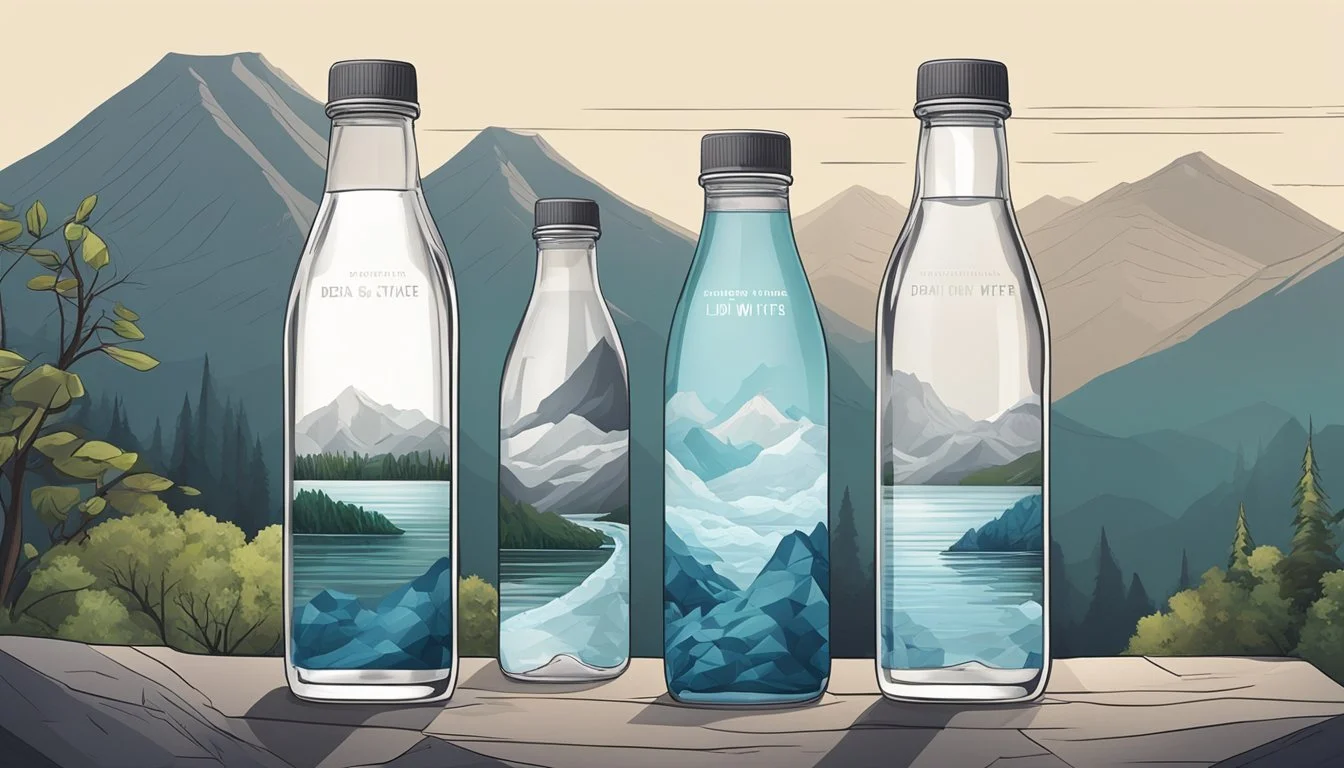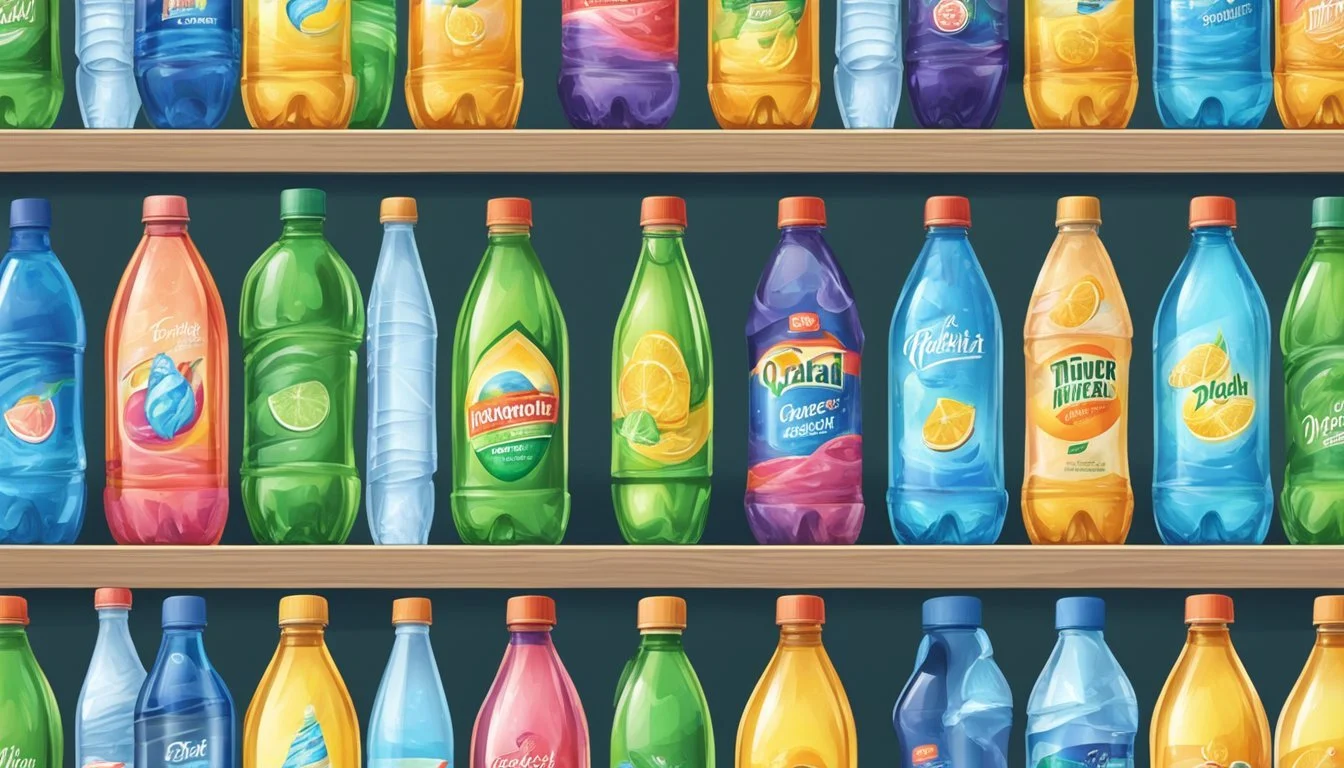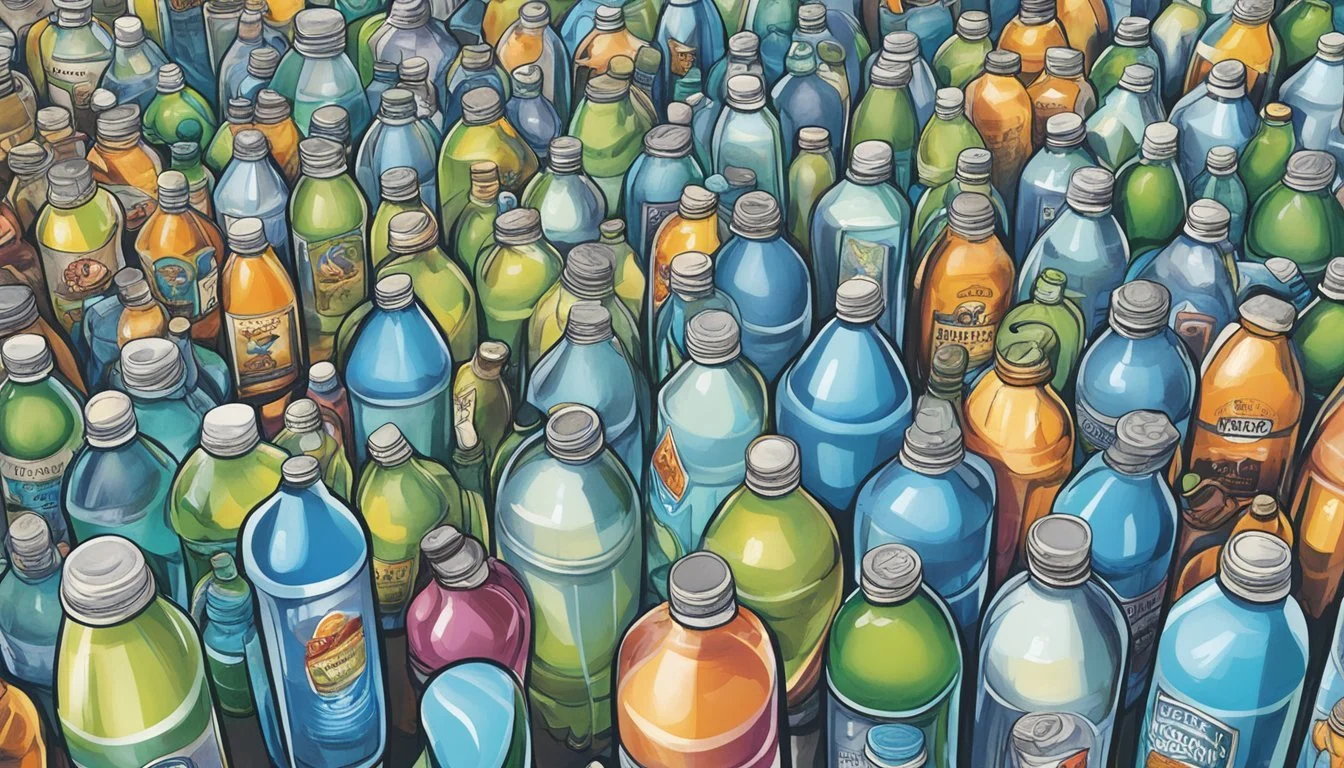Liquid Death vs. Open Water
Comparing Bottled Water Brands
Choosing between Liquid Death and Open Water can feel like a challenge given the variety of options in the bottled water market. Each brand offers distinct advantages that cater to different consumer preferences and environmental concerns. For those prioritizing eco-friendliness, Liquid Death, with its recyclable aluminum cans, may hold an edge over the plastic-free yet slightly less publicized Open Water.
Liquid Death packs its water in aluminum cans, promoting sustainability while also providing both sparkling and still water options. This approach appeals to consumers who are increasingly conscious of plastic waste and its environmental impact. On the other hand, Open Water offers a similar commitment to sustainability, also utilizing aluminum packaging but focusing more explicitly on purified still water options.
When evaluating the overall impact on health and the environment, Liquid Death is often seen as the better choice due to its straightforward approach to eliminating plastic waste, accompanied by a refreshing taste profile. Whether you prefer the fizziness of sparkling water or the straightforwardness of still water, the ultimate decision may hinge on personal taste and commitment to reducing single-use plastic consumption. Readers should weigh these factors carefully to determine which brand aligns best with their lifestyle.
Industry Overview
The bottled water industry has seen significant changes in both market dynamics and environmental considerations. Key aspects include the diversification of product offerings and increasing concerns about the impact of plastic waste.
Evolution of the Bottled Water Market
The bottled water market has evolved considerably over the past few decades. Initially dominated by major brands like Evian and Dasani, the market now includes a diverse range of products, from traditional bottled water to sparkling and flavored options.
Brands such as Liquid Death and Open Water exemplify this shift. Liquid Death, known for its edgy marketing, offers canned water, appealing to consumers looking for alternatives to plastic. Open Water aims to reduce single-use plastic by using aluminum bottles, which are more recyclable.
The entry of these eco-friendly brands reflects a broader consumer trend toward environmentally responsible products. In addition, the market has expanded to include water sourced from varied locations, such as springs, glaciers, and even municipal sources, each touting unique benefits.
Environmental Impact of Bottled Beverages
The environmental impact of bottled beverages, especially water, is significant. Traditional plastic water bottles contribute substantially to pollution, taking hundreds of years to decompose. This has led to a growing backlash against single-use plastics.
Brands like Liquid Death and Open Water are responding to this challenge by using aluminum packaging. Aluminum is more recyclable and has a lower environmental footprint compared to plastic. This shift is aimed at reducing the amount of plastic waste entering landfills and oceans.
Moreover, companies are increasingly focusing on sustainable practices, such as using renewable energy in production and promoting recycling. Consumers are also more eco-conscious, driving demand for products that align with their environmental values.
Brand Analysis
This analysis explores the distinct branding strategies of Liquid Death and Open Water, emphasizing their unique market approaches and environmental commitments.
Liquid Death's Brand Persona
Liquid Death has disrupted the bottled water market with its bold "Murder Your Thirst" tagline, which mimics the aggressive branding of energy drinks.
The brand targets a younger demographic by presenting itself as edgy and rebellious. Its packaging—a black aluminum can with skull graphics—enhances this persona.
This unique marketing strategy differentiates Liquid Death from conventional water brands. The brand's commitment to an eco-friendly image is evident through its use of 70% recycled aluminum, capitalizing on the mantra "Death to Plastic." Liquid Death combines hydration with a metal-inspired aesthetic to stand out in a crowded market.
Open Water's Sustainability Promise
Open Water positions itself as an eco-conscious brand focused on sustainability.
They emphasize reducing plastic waste and improving ocean health via aluminum packaging. Open Water's cans are recyclable, aligning with their mission to create "a loving home for plastic alternatives." The brand also engages in carbon offset programs and claims carbon neutrality as part of its commitment to environmental responsibility.
Their marketing portrays a responsible, environmentally aware company, targeting consumers who prioritize sustainability. This focus makes Open Water appealing to eco-conscious individuals looking for alternatives to traditional plastic bottled water.
By providing detailed brand personas and sustainability commitments, consumers can better understand the differences between Liquid Death and Open Water.
Product Offerings
Liquid Death and Open Water both offer a range of product options catering to different preferences. They vary significantly in their approach to packaging and the types of water they provide.
Variety and Flavors
Liquid Death offers both still and sparkling water. Their sparkling water comes in several flavors, including lime and berry. The brand focuses on delivering high-quality water options with a bold brand image, appealing to those seeking a unique twist on their hydration needs.
Open Water, on the other hand, primarily features still water. They emphasize the purity and taste of their water, without branching into flavored options. This makes Open Water a go-to for consumers prioritizing simplicity and flavor purity in their water choices.
Packaging Differences
Liquid Death packages its water in aluminum cans. These cans are both infinitely recyclable and provide an eco-friendly alternative to traditional plastic bottles, appealing to environmentally conscious consumers. Sizes vary, with tallboy and king-size options available.
Open Water also opts for aluminum cans, promoting sustainability and reducing plastic waste. While their range may be less varied in flavor compared to Liquid Death, the packaging ensures a lower environmental impact. The brand's focus remains on providing high-quality water in a sustainable format, aligning with modern ecological priorities.
Consumer Experience
Consumers often base their choice of bottled water on taste, drinkability, and health benefits. Both Liquid Death and Open Water offer unique attributes that cater to these preferences.
Taste Profile and Drinkability
Liquid Death offers sparkling and flat options. The unflavored versions are praised for their clean, refreshing taste without an aftertaste. The slight tang in the sparkling variant adds a crisp, fizzy experience. Some consumers find the flavored options less appealing.
Open Water also comes in still and sparkling forms. The brand emphasizes a pure and natural taste. Many consumers appreciate the lack of metallic or plastic flavors found in some bottled waters. The sparkling version has a gentle fizz that enhances its refreshing qualities.
Hydration and Health Benefits
Both brands focus on providing high-quality hydration options. Liquid Death emphasizes its use of natural mountain water, free from artificial additives. The plain variants are suitable for those looking to maintain proper hydration without added sweetness or calories.
Open Water, similarly, offers a healthy hydration solution. The water is sourced and bottled to prioritize purity and healthfulness. Additionally, its eco-friendly aluminum packaging aligns with health-conscious consumers who are also environmentally aware. This combination of health and sustainability makes Open Water a compelling choice.
Environmental and Health Consciousness
Comparing Liquid Death and Open Water involves examining their environmental impact and health implications. Liquid Death uses aluminum cans, while Open Water opts for plastic or glass bottles.
Eco-Friendly Initiatives
Liquid Death opts for aluminum cans, leveraging their infinite recyclability. Aluminum requires less fuel during transportation due to its lightweight nature, reducing carbon emissions. Conversely, Open Water often uses plastic, contributing heavily to pollution. Glass bottles, another option from Open Water, are fully recyclable but heavier, leading to higher transit emissions.
Liquid Death promotes sustainability by using recycled materials. Their marketing highlights reducing plastic waste, resonating with eco-conscious consumers. On the other hand, Open Water's plastic bottle usage has fewer eco-friendly benefits, despite their focus on reusable options.
Impact on Human Health
The health implications of both brands come under scrutiny. Liquid Death offers unflavored, additive-free water. Packaged in aluminum, it avoids the potential toxins from plastic leaching. This gives Liquid Death a slight edge in health consciousness.
Open Water, however, uses plastic and glass bottles, which may pose risks if not BPA-free. Plastic can leach toxins into water, especially in high temperatures. Glass, while safer, is less practical due to weight and breakability. Therefore, consumers should consider these factors when assessing the health benefits of each brand.
Market Presence
Both Liquid Death and Open Water have established themselves as significant players in the premium bottled water market. The brands utilize distinct strategies to appeal to consumers through various retail and online channels, as well as through targeted social media and advertising campaigns.
Retailer and Online Distribution
Liquid Death leverages a strong presence in physical and online retail channels. Major retailers such as Target and Amazon stock their products, making them easily accessible. Their water in a can format appeals to environmentally conscious consumers by offering a more sustainable alternative.
Open Water, similarly, has focused on broad retailer distribution. It is available in various brick-and-mortar stores and e-commerce platforms. They emphasize sustainability, which resonates well with a growing demographic of eco-conscious buyers.
Both brands employ effective supply chains to maintain consistent stock levels. Sales metrics indicate significant growth in these distribution channels, reflecting consumer demand.
Social Media and Advertising Influence
Liquid Death uses bold, often shocking advertising tactics to capture consumers' attention. Their marketing campaigns prominently feature on platforms like Instagram and Netflix, targeting millennials and Gen Z. The brand's social media strategy includes humorous and edgy content that aligns with its "outlaw" persona.
Open Water's advertising efforts focus more on sustainability and health benefits. They utilize social media platforms to educate consumers about the environmental impact of plastic bottles. Their campaigns, while less aggressive, highlight their commitment to eco-friendly practices.
Both brands effectively engage with their audiences through regular updates and interactive content, fostering strong brand loyalty and social media engagement.
Cultural Impact
Liquid Death and Open Water have carved unique identities in the bottled water market with distinct cultural impacts through celebrity endorsements, collaborations, and robust user engagement. These factors have significantly shaped their brand images and loyalty.
Celebrity Endorsements and Collaborations
Liquid Death has leveraged high-profile endorsements to boost its edgy brand. Travis Barker, the drummer for Blink-182, is among its notable backers, which aligns perfectly with its rebellious image. The brand's gothic-styled cans, emblazoned with skulls, appeal to a young, alternative demographic and have been featured in concerts and events organized by Live Nation.
Open Water collaborates with environmentally conscious celebrities and organizations, amplifying its sustainability message. While it lacks the punk rock allure of Liquid Death, it gains traction among eco-minded consumers. Whole Foods often carries their products, attracting an audience that prioritizes sustainability.
User Engagement and Community
Liquid Death excels in creating a community through social media platforms like TikTok and Instagram. Their content often goes viral, featuring humorous and irreverent marketing that resonates with fans. The brand encourages user-generated content, bolstering a sense of belonging among its consumers. Events at bars and music festivals further cement this community spirit.
Open Water focuses on educational content related to environmental conservation. Their community engagement involves campaigns promoting reduced plastic usage and partnerships with ecological nonprofits. Their digital presence is strong but more informational, appealing to a different, more eco-conscious audience.
Comparative Analysis
Liquid Death and Open Water cater to distinct consumer preferences, heavily influenced by cost, environmental impact, and branding. Understanding these factors helps consumers make an informed choice between these two brands.
Cost and Value Proposition
Liquid Death typically sells Mountain Water for around $1.62 per can. Open Water, emphasizing sustainability, offers similar pricing but positions itself as a premium product due to its environmental benefits.
Value comparison becomes crucial here. Liquid Death highlights its bold branding and recycled aluminum cans. Open Water focuses on waste reduction with eco-friendly packaging and promoting the slogan "Death to Plastic." For those concerned with sustainability, Open Water often appears more attractive despite similar price points.
Customer Loyalty and Brand Trust
Both brands leverage strong branding and marketing strategies. Liquid Death's unique marketing, portraying water refreshment as a rebellious act, has gained it significant sales and a dedicated following. Customers appreciate its edgy approach and aluminum packaging.
Open Water builds trust through its unwavering commitment to environmental causes. Consumers who prioritize sustainability and reducing plastic waste often show a higher level of brand loyalty. This commitment is communicated clearly through their packaging and initiatives, appealing to eco-conscious buyers who seek dependable, environmentally friendly products.
Potential for Innovation
Both Liquid Death and Open Water have opportunities to innovate further, especially regarding future product developments and evolving environmental considerations.
Future Product Developments
Liquid Death has already made strides with sparkling waters and still water offerings. Expanding into other beverage categories like iced tea or energy drinks could attract a wider consumer base.
The brand’s edgy marketing may also lend itself well to unique flavors or collaborations with popular cultural figures. Moreover, sourcing water from pristine regions such as the Austrian Alps can add an exclusive appeal.
Open Water, known for its commitment to sustainability, could explore similar avenues. Introducing functional beverages, infused waters, or limited-edition seasonal products can enhance its market presence.
Including innovations like enhanced packaging with QR codes for brand storytelling can further engage customers.
Evolving Environmental Considerations
Sustainability remains a core focus for both brands. Liquid Death's use of aluminum cans significantly reduces plastic waste, aligning with growing consumer demand for eco-friendly products.
Optimizing transportation logistics to reduce carbon emissions can also make a substantial impact. Utilizing renewable energy sources for production facilities would further solidify their environmental commitment.
Open Water pioneered the use of refillable canned water, emphasizing circular economy principles. They could innovate further by incorporating more recycled materials into their packaging.
Advancing partnerships with environmental organizations can also boost credibility. Consumers are increasingly conscious of the lifecycle of their purchases, making transparency and accountability essential.
Overall, both brands have substantial opportunities to advance in product diversity and ecological responsibility, tailoring strategies to meet modern consumer demands.
Conclusion
When comparing Liquid Death and Open Water, both brands emphasize sustainability by using aluminum cans instead of plastic bottles.
Liquid Death offers a range of flavors like Convicted Melon, Armless Palmer, and Severed Lime. Open Water, on the other hand, focuses on plain sparkling and still water.
In terms of hydration, both brands effectively meet daily needs.
Liquid Death's unique and edgy marketing approach has garnered significant attention. Open Water's branding is more traditional, appealing to environmentally conscious consumers.
Their commitment to environmental stewardship is evident in their packaging choices. Aluminum cans are more recyclable than plastic.
Both brands are carried by various stores, making them accessible to consumers.
Liquid Death's bold branding might appeal to a younger demographic, while Open Water's straightforward messaging attracts those primarily focused on sustainability.
In essence, both brands offer valuable choices for consumers seeking hydration options in environmentally friendly packaging.
More About Liquid Death
Aqua Carpatica vs Liquid Death: Which Bottled Water is Better?
Core Hydration vs Liquid Death: Which Bottled Water is Better?
Hawaii Volcanic vs Liquid Death: Which Bottled Water is Better?
Hawaiian Springs vs Liquid Death: Which Bottled Water is Better?
Ice Mountain vs Liquid Death: Which Bottled Water is Better?
Icelandic Glacial vs Liquid Death: Which Bottled Water is Better?
Liquid Death vs Cascade Mountain: Which Bottled Water is Better?
Liquid Death vs Crystal Geyser: Which Bottled Water is Better?
Liquid Death vs Crystal Lake: Which Bottled Water is Better?
Liquid Death vs Essence pH10: Which Bottled Water is Better?
Liquid Death vs Kirkland Signature: Which Bottled Water is Better?
Liquid Death vs Proud Source: Which Bottled Water is Better?
Liquid Death vs Richard's Rainwater: Which Bottled Water is Better?
Liquid Death vs Simple Truth: Which Bottled Water is Better?
Liquid Death vs Talking Rain AQA: Which Bottled Water is Better?
Liquid Death vs Whole Foods 365: Which Bottled Water is Better?
Liquid Death vs Whole Foods Italian Still Mineral water: Which Bottled Water is Better?
Mountain Valley Spring Water vs Liquid Death: Which Bottled Water is Better?
Nestle Pure Life vs Liquid Death: Which Bottled Water is Better?
Poland Spring vs Liquid Death: Which Bottled Water is Better?
Purely Sedona vs Liquid Death: Which Bottled Water is Better?
San Pellegrino vs Liquid Death: Which Bottled Water is Better?
Solan de Cabras vs Liquid Death: Which Bottled Water is Better?
More About Open Water
Aqua Carpatica vs Open Water: Which Bottled Water is Better?
Cascade Mountain vs Open Water: Which Bottled Water is Better?
Core Hydration vs Open Water: Which Bottled Water is Better?
Crystal Geyser vs Open Water: Which Bottled Water is Better?
Hawaii Volcanic vs Open Water: Which Bottled Water is Better?
Hawaiian Springs vs Open Water: Which Bottled Water is Better?
Icelandic Glacial vs Open Water: Which Bottled Water is Better?
Mountain Valley Spring Water vs Open Water: Which Bottled Water is Better?
Nestle Pure Life vs Open Water: Which Bottled Water is Better?
Open Water vs Kirkland Signature: Which Bottled Water is Better?
Open Water vs Whole Foods 365: Which Bottled Water is Better?
Richard's Rainwater vs Open Water: Which Bottled Water is Better?
San Pellegrino vs Open Water: Which Bottled Water is Better?
Solan de Cabras vs Open Water: Which Bottled Water is Better?
Talking Rain AQA vs Open Water: Which Bottled Water is Better?
Whole Foods Italian Still Mineral water vs Open Water: Which Bottled Water is Better?







